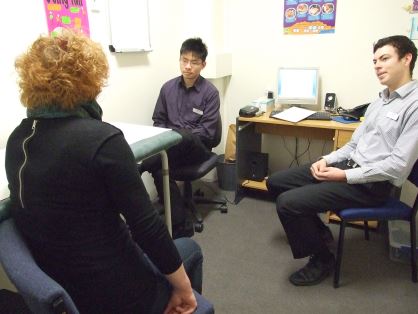
Medical students at the SECO clinic.
The Safe and Effective Clinical Outcomes (SECO) clinic was conceived in 2004 by two rural General Practitioners, Dr Trevor Walker and Dr Martyn Williamson, as a way for undergraduate medical students to learn about clinical practice.
Key features of the SECO clinic
- Unobserved, true-to-life patient encounters in a simulated general practice
- Open access to resources (texts, internet, or phone advice from a senior colleague)
- Student control of time management for the duration of the clinic
- Formative and summative assessment which aligns assessment, clinical teaching, learning, and future professional practice
- Focus on the outcomes of the consultation
Performance measures
- Safe and effective clinical outcomes for the patient
- The ease with which these are achieved (proficiency)
SECO criteria
Safe outcomes
- No increased risk of harm in the short or long term to either the patient or the doctor
Effective outcomes
- Carefully defined and unique for each scenario
- Evidence-based, patient-centred, context-sensitive, resource-efficient
Proficiency of practice
- The ease with which SECO is achieved, measured by duration of encounter and use of additional resources (for example, telephone advice from senior colleagues)
Assessment and feedback methods
- Students are assessed on their achievement of predetermined SECO patient outcomes by reference to their written clinical notes
- Questionnaires completed by the simulated patients whilst still in role (each questionnaire is specially prepared for each scenario)
- Students receive written feedback, including the completed patient questionnaire, their own clinical notes, the list of outcomes to be achieved, and detailed background of what constituted SECO for each scenario
- Each clinic is followed by a 90-minute group debrief to analyse outcomes and review learning issues identified by the participants
Benefits of SECO clinics
- Integrated clinical performance
- Repeated practice and assessment in an authentic simulation of clinical practice
- Prompt and detailed feedback on the achievement of outcomes
- Outcomes based on relevant patient benefits - safety and effectiveness
- Help in recognising their own limitations and developing ways of managing uncertainty
Further information
The SECO clinic is described in the following publications:
Williamson, M., Walker, T., Egan, T., Storr, E., Ross, J., & Kenrick, K. (2013). The Safe and Effective Clinical Outcomes (SECO) clinic: Learning responsibility for patient care through simulation, Teaching and Learning in Medicine: An International Journal, 25(2), 155–158, DOI:10.1080/10401334.2013.772016.
The Safe and Effective Clinical Outcomes (SECO) clinic: Learning responsibility for patient care through simulation
Background: This article describes a simulated general practice clinic for medical students, which incorporates specific features to aid learning of clinical problem solving.
Description: We outline the overall objectives of the simulation, explain the concept, and describe how the clinic works. The clinic is novel in that it utilises clinical outcomes as measures for student success in the consultation. There are no time restrictions on a consultation. Students are unobserved and have open access to clinical information and telephone advice from a senior colleague.
Evaluation: The achievement of the case-specific outcomes is assessed by reference to students' clinical notes and the responses of the simulated patients to specific scenario-related questions. Following the clinic there is a debrief session, and students are provided with the evidence base and outcomes for each scenario.
Conclusions: The clinic has been part of our undergraduate curriculum since 2004. Collectively, students rate it as their most effective learning experience.
Young, J. E., Williamson, M. I.,& Egan, T. G. (2015). Students' reflections on the relationships between safe learning environments, learning challenge and positive experiences of learning in a simulated GP clinic. Advances in Health Sciences Education,1-15. DOI: 10.1007/s10459-015-9611-3.
Students' reflections on the relationships between safe learning environments, learning challenge and positive experiences of learning in a simulated GP clinic.
Learning environments are a significant determinant of student behaviour, achievement and satisfaction. In this article we use students' reflective essays to identify key features of the learning environment that contributed to positive and transformative learning experiences. We explore the relationships between these features, the students' sense of safety in the learning environment (LE), the resulting learning challenge with which they could cope and their positive reports of the experience itself. Our students worked in a unique simulation of General Practice, the Safe and Effective Clinical Outcomes clinic, where they consistently reported positive experiences of learning. We analysed 77 essays from 2011 and 2012 using an immersion/crystallisation framework. Half of the students referred to the safety of the learning environment spontaneously. Students described deep learning experiences in their simulated consultations. Students valued features of the LE which contributed to a psychologically safe environment. Together with the provision of constructive support and immediate, individualised feedback this feeling of safety assisted students to find their own way through clinical dilemmas. These factors combine to make students feel relaxed and able to take on challenges that otherwise would have been overwhelming. Errors became learning opportunities and students could practice purposefully. We draw on literature from medical education, educational psychology and sociology to interpret our findings. Our results demonstrate relationships between safe learning environments, learning challenge and powerful learning experiences, justifying close attention to the construction of learning environments to promote student learning, confidence and motivation.
Video introduction to SECO clinics
Javascript must be enabled to play this media.
Video introduction to SECO clinics (99MB mp4)
This video includes an entire consultation conducted by a student at the end of his first clinical year. Please view in conjunction with the following documents:
- Clinical record for Coral Grant (PDF 30 KB)
- Actor's role for Coral Grant (PDF 150 KB)
- Actor feedback form (PDF 50 KB)
- Student's clinical notes for Coral Grant (PDF 50 KB)
- Clinical details of Coral Grant (PDF 120 KB)
- Summary of clinical notes for Coral Grant (PDF 30 KB)